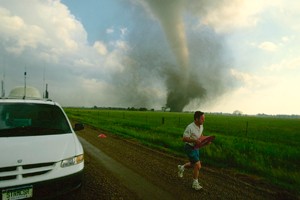
SATURDAY: National Geographic Severe-Storms Researcher Gives Free Talk Today at Fifth Third Arena
(SEE). A morning of chemistry demonstrations, hands-on science and movies will be topped off by a keynote presentation from Tim Samaras, National Geographic severe-storms researcher.
As families scramble to avoid deadly tornadoes, Tim Samaras races straight toward them. He careens across the United States notorious Tornado Alley on a mission: Predict the exact coordinates of an unborn tornado, arrive before it does, and place a weather-measurement probe directly in the twisters violent, swirling path.
Data from the probes help us understand tornado dynamics and how they form. With that piece of the puzzle we can make more precise forecasts and ultimately give people earlier warnings, Samaras explains. Since current warnings average a slim 13 minutes, every extra second of warning can be a lifesaver for residents facing a twisters wrath.

Tornado.
It all started when I was about six years old and saw that fantastic tornado in The Wizard of Oz, Samaras says. About 20 years ago, he began storm chasing. Now he spends every May and June putting 25,000 miles on his vehicle, chasing zigzagging tornadoes across the Plains.
About five years ago, as an engineer, he designed the next generation of probe to measure pressure drops inside tornadoes. A history-making instrument, Samarass turtle probe has recorded record-breaking drops in pressurethe condition that triggers a tornados extreme wind speeds.
This information is especially crucial, Samaras says, because it provides data about the lowest 10 meters [33 feet] of a tornado, where houses, vehicles, and people are. A 6-inch-high weather station encased in steel, the probe has sensors that measure humidity, pressure, temperature, wind speed, and direction.
His car jammed with GPS gear, radios, scanners, a wireless Internet connection, and satellite tracking devices, Samaras constantly checks the forecast, data, and sky. I only have one shot at being at the right spot, he says. The worst is being five minutes late. One traffic jam or detour and you can miss the whole show. Thats why we try to anticipate the action and arrive while theres still nothing but blue sky. The storms develop right over our heads, and we follow them as they form.

Tim Samaras.
Often the fury fizzles. Tornadoes develop from only two out of every ten storms Samaras follows. And deploying a probe is only possible during two out of every ten tornadoes. The odds are really against us, he admitted. Storm chasing is probably the most frustrating thing one can do.
Students who received a superior rating at their schools science fairs were eligible to compete at UCs SEE, which is the Southwest District (District 11) for the Ohio Academy of Science for the counties of Hamilton, Preble, Warren, Butler and Clermont. Approximately 400 students in grades 7 through 12 will have spent the morning with their projects competing for an all-time high of $73,000 in awards and scholarships.
But first theyll be thinking about...tornadoes.
Samarass presentation is free and open to the public. The keynote will be held on the University of Cincinnati campus at 3 p.m., Saturday, March 14, 2009, in the Fifth Third Arena of the Myrl H. Shoemaker Center.
Tags
- College of Pharmacy
- College of Education, Criminal Justice, & Human Services
- Student Affairs
- Clermont College
- College of Allied Health Sciences
- College of Arts and Sciences
- College-Conservatory of Music
- College of Engineering and Applied Science
- College of Nursing
- Blue Ash College
- College of Law
- College of Medicine
Related Stories
OTR mural centerpiece of 'big' celebration of UC alumni
April 26, 2024
New downtown artwork salutes 18 alumni award recipients who personify UC’s alumni success.
UC Exercise Science Expo highlights community connections and...
April 24, 2024
On March 28, 2024, the University of Cincinnati’s Exercise Science (EXSC) program, part of the School of Human Services, hosted the university’s inaugural Exercise Science Expo in the Tangeman University Center. The event, which was open to UC EXSC students, brought together industry representatives, community partners and recent alumni for a full day of networking, special speakers, internship and job opportunities, and more.
UC hires Dr. Gregory Postel as senior vice president of health...
April 23, 2024
UC Board of Trustees vote to hire Dr. Gregory Postel as senior vice president of health affairs and dean of UC College of Medicine.
